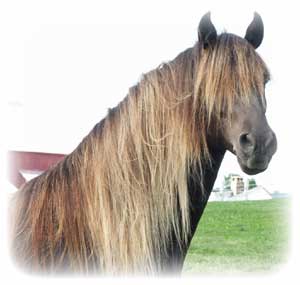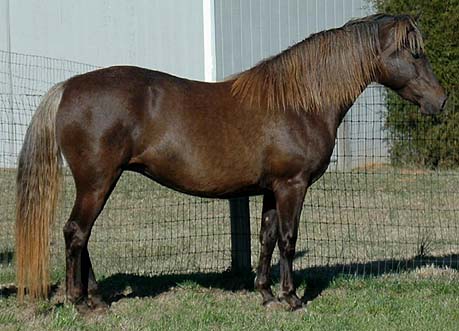The silver, silver dapple, chocolate flax or Taffy gene




silver, silver dapple, chocolate flax and Taffy are all caused by the same geneSilver, or silver dapple is the common term used for horses with a dilution gene that works to dilute black pigment. The gene usually causes a partial lightening of black pigment in the body coat and a more extreme lightening (or “silvering”) of the mane and tail. The dilution effect is often, but not necessarily, accompanied by dappling. The name silver dapple should probably be reserved for horses that have both dapples and a silver mane and tail. Not all horses with the dilution gene look like that. Similarly the term "chocolate" is often used in the Rocky Mountain Horse breed, but doesn’t describe the color of all horses with the dilution gene. Taffy is a more general term that’s sometimes used and is probably a better one since the dilution gene can occur in horses of any color of base coat, giving different visual affects accordingly, but it isn't generally accepted, and the term silver is now more usual. The silver gene is denoted by the symbol “Z” and the dilution allele is dominant over non-dilution.
The silver gene is said not to affect chestnut horses so that from time to time a chestnut horse carrying silver can have an unexpected color of foal. However I know of some miniature horses breeders who believe it does have a subtle affect, and that they can tell which of their chestnut horses carries silver on the basis of what they look like. Silver changes black body coat pigment to a color that ranges from a creamy chocolate to a deep bluish gray to a deep orangey red. Manes and tails are often, but not always, turned to white or very nearly white, often said to be “silvery”. Such manes and tails are often mistaken for flaxen, but unlike with flaxen the roots are dark. Silver horses may often have a dark mask on the face, similar to that which occurs in dun horses. They may also have striped hooves, and often have light blonde or white eyelashes, especially as foals. Bay horses with the silver gene are turned to a bright reddish orange with rich chocolate or tan points. The mane and tail are blonde, sometimes streaked with silvery black hairs. They may look like flaxen chestnut but their manes and tails have dark rather than flxen roots. Brown horses with silver are unusual and quite stunning. Their coats are a dark bluish gray, like slate, but with an orangish highlights. The mane and tail contains an admixture of black and blonde hairs, making them appear silvery. Black horses with silver can either be silver dapple itself or chocolate (called chocolate flax in some breeds). Both are most attractive colors. Silver dapple horses have a sepia brown colored body with cream or flaxen dapples, which are especially striking on horses with a darker coats. Their manes and tails are flaxen or ivory. Dark silvers without dapples are called chocolate or choclate flax, and are especially common among the Rocky Mountain breed of gaited horses. Their manes and tails may be flaxen or silver, but can also be somewhat darker chocolatey color.
The silver gene has been identifiedThe gene responsible for the Silver dilution is in the PMEL17 gene on horse chromosome 6 (Brunberg et al, 2006, Reissmann et al, 2007).
Both Brunberg et al (2006) and Reissmann et al (2007) seem to have independently found mutations in exon 11 and intron 9, completely associated with silver (an exon is a coding region of the gene). A silver dilution test assays for mutation sites in both places. Pmel17 is a membrane protein in melanosomes that is active from quite early in embryonic development. It is active in mature melanosomes also, and is involved with the production of the black pigment eumelanin. Pmel17 mutations are known to be related to pigmentation in other animals, including premature silvering in mice, diluted and white plumage in chickens, and the merle dilution in dogs. The merle coat in dogs is associated with deafness and eye disorders. Pmel17 mutations in zebrafish are also associated with vision defects.
|








